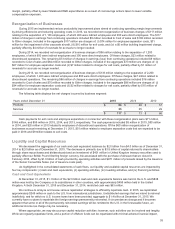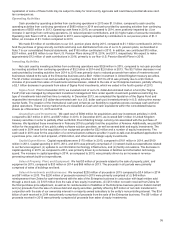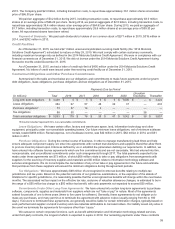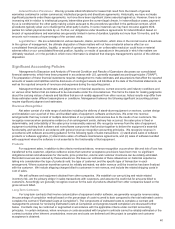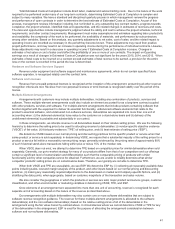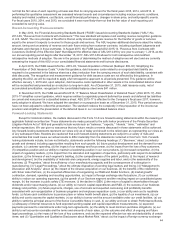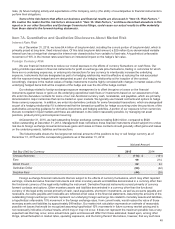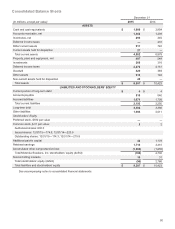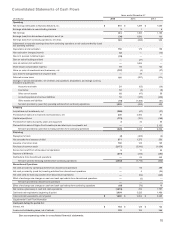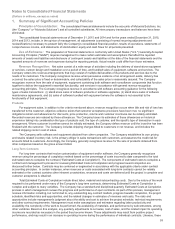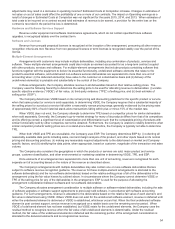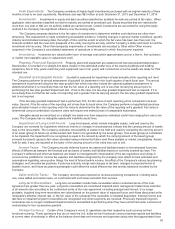Motorola 2015 Annual Report Download - page 46
Download and view the complete annual report
Please find page 46 of the 2015 Motorola annual report below. You can navigate through the pages in the report by either clicking on the pages listed below, or by using the keyword search tool below to find specific information within the annual report.
45
risks, (b) future hedging activity and expectations of the Company, and (c) the ability of counterparties to financial instruments to
perform their obligations.
Some of the risk factors that affect our business and financial results are discussed in “Item 1A: Risk Factors.”
We caution the reader that the risk factors discussed in “Item 1A: Risk Factors,” and those described elsewhere in this
report or in our other Securities and Exchange Commission filings, could cause our actual results to differ materially
from those stated in the forward-looking statements.
Item 7A. Quantitative and Qualitative Disclosures About Market Risk
Interest Rate Risk
As of December 31, 2015, we have $4.4 billion of long-term debt, including the current portion of long-term debt, which is
primarily priced at long-term, fixed interest rates. Of this total long-term debt amount, a $29 million Euro-denominated variable
interest loan has a hedge that changes the interest rate characteristics from variable to fixed-rate. A hypothetical unfavorable
movement of 10% in the interest rates would have an immaterial impact on the hedge’s fair value.
Foreign Currency Risk
We use financial instruments to reduce our overall exposure to the effects of currency fluctuations on cash flows. Our
policy prohibits speculation in financial instruments for profit on exchange rate price fluctuations, trading in currencies for which
there are no underlying exposures, or entering into transactions for any currency to intentionally increase the underlying
exposure. Instruments that are designated as part of a hedging relationship must be effective at reducing the risk associated
with the exposure being hedged and are designated as part of a hedging relationship at the inception of the contract.
Accordingly, changes in the market values of hedge instruments must be highly correlated with changes in market values of the
underlying hedged items both at the inception of the hedge and over the life of the hedge contract.
Our strategy related to foreign exchange exposure management is to offset the gains or losses on the financial
instruments against losses or gains on the underlying operational cash flows or investments based on our assessment of risk.
We enter into derivative contracts for some of our non-functional currency cash, receivables, and payables, which are primarily
denominated in major currencies that can be traded on open markets. We typically use forward contracts and options to hedge
these currency exposures. In addition, we enter into derivative contracts for some forecasted transactions, which are designated
as part of a hedging relationship if it is determined that the transaction qualifies for hedge accounting under the provisions of the
authoritative accounting guidance for derivative instruments and hedging activities. A portion of our exposure is from currencies
that are not traded in liquid markets and these are addressed, to the extent reasonably possible, by managing net asset
positions, product pricing and component sourcing.
At December 31, 2015, we had outstanding foreign exchange contracts totaling $494 million, compared to $628
million outstanding at December 31, 2014. Management does not believe these financial instruments should subject it to undue
risk due to foreign exchange movements because gains and losses on these contracts should generally offset gains and losses
on the underlying assets, liabilities and transactions.
The following table shows the five largest net notional amounts of the positions to buy or sell foreign currency as of
December 31, 2015 and the corresponding positions as of December 31, 2014:
Notional Amount
Net Buy (Sell) by Currency 2015 2014
Chinese Renminbi $(114)$(161)
Euro 99 214
British Pound 62 34
Australian Dollar (60) (42)
Brazilian Real (44) (28)
Foreign exchange financial instruments that are subject to the effects of currency fluctuations, which may affect reported
earnings, include derivative financial instruments and other monetary assets and liabilities denominated in a currency other than
the functional currency of the legal entity holding the instrument. Derivative financial instruments consist primarily of currency
forward contracts and options. Other monetary assets and liabilities denominated in a currency other than the functional
currency of the legal entity consist primarily of cash, cash equivalents, short-term investments, as well as accounts payable and
receivable. Accounts payable and receivable are reflected at fair value in the financial statements. Assuming the amounts of the
outstanding foreign exchange contracts represent our underlying foreign exchange risk related to monetary assets and liabilities,
a hypothetical unfavorable 10% movement in the foreign exchange rates, from current levels, would reduce the value of those
monetary assets and liabilities by approximately $49 million. Our market risk calculation represents an estimate of reasonably
possible net losses that would be recognized assuming hypothetical 10% movements in future currency market pricing and is
not necessarily indicative of actual results, which may or may not occur. It does not represent the maximum possible loss or any
expected loss that may occur, since actual future gains and losses will differ from those estimated, based upon, among other
things, actual fluctuation in market rates, operating exposures, and the timing thereof. We believe, however, that any such loss


